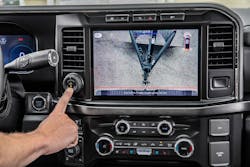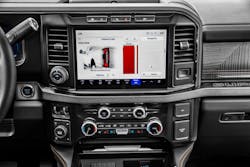ROMEO, Michigan—“Everything that we've learned, we put it all in this truck,” asserted Tim Baughman, general manager of Ford Pro, revving up members of the media for a day of test driving—and sometimes torture testing—various 2023 Ford F-Series Super Duty trucks at the Ford Michigan Proving Ground. The verdant, nearly 4,000-acre property teemed with wildlife and wilder roads, which Ford used to prove that their vehicles are as tough as advertised.
After driving various Super Duty trims in towing and off-road applications, we can confirm the Super Duty is one tough truck. And while we can’t confirm “everything” Ford claimed was put in these trucks, we can attest to the fact that there is a whole lot of innovation crammed into the 2023 Super Duty—from the cab to the tailgate.
This is appropriate, as the Super Duty, and new commercial business Ford Pro, are both “all about adding end-to-end solutions for customers to minimize the pain points and to drive uptime for that business,” Baughman said.
Read more: Trends from pickup trucks' Big ThreeSpecifically, he lauded the F-Series’ market share dominance and impact on U.S. productivity.
Ford has a “41% market share for Class 1 through 7—it's around double our closest competitor,” Baughman noted. In construction, for example, the Super Duty has a 46% share, while the next closest competitor is 24%, based on Ford’s internal data.
He also noted the 2023 lineup as the most connected Super Duty, as it comes with a 5G modem which can provide Wi-Fi for up to 10 devices while also aiding in faster mapping and navigation. The modem also transmits data back to Ford and the fleet, which is used to improve functionality and is starting to be used for predictive maintenance.
“The integrated diagnostic data that we have will allow us and the fleets to actually see what's going on in their vehicle at all times,” said Matt Wilczewski, Ford Pro tech sales manager. “Not only will the information go from the vehicle to the fleet customer, but the fleet customer can also see any issues that come up with the vehicle, whether it's a warning indicator light, an engine malfunction indicator light, or whether or not it's scheduled maintenance.”
Scheduling tire rotations would be done by looking at tire mileage hours, while oil changes could be based on oil life remaining.
“It is all about harnessing the data on the vehicle…and taking all that rich data in the cloud and understanding how our vehicles are being used for our customers,” Baughman said. “We know how their trucks are being used…and how we can make the truck even better to do the work that it needs to do.”
One of these efficiency-improving additions is Pro Trailer Hitch Assist, a driver-assist feature that takes the guesswork out of aligning the truck hitch ball to trailer hitch by automatically doing it for you.
The goal is to reduce the amount of time a driver might take to hook up a trailer. Getting it right the first time means more time the truck can be productive.
Baughman described one Super Duty customer, a “young guy fresh out of college” with a landscaping business, hitched three different trailers to his truck in three hours, switching from a dump trailer full of stone to a flatbed with a Bobcat. Every minute he saved on set-up went into execution time, so the job was done quicker and he could get back home sooner or add an extra job.
Because 90% of Super Duty owners perform heavy-haul operations, according to Ford, this feature will likely be one of the most appreciated new driver-assist additions, especially since it's super easy to use.
When the truck is in tow mode, the driver can press a button on the dash and the system uses its machine learning to calculate the speed and angle of approach to perfectly stop under the trailer hitch. You need to be within 20 feet for the process to begin.
As the truck backs ups, the driver can verify that the hitch is on the right path via a virtual dotted white line on the vehicle's 12-inch SYNC 4 infotainment touchscreen (8-inch for base XL trim).
Even if you don’t yet trust AI, the screen and white line still helps you get close manually. Despite what my name suggests, I’d never attempted to connect a truck to a trailer, but got it within a few inches on my first manual try. The AI did show me up by getting it right the first time. The giant Canadian storm chaser in my media group also got it right the first time manually, but who’s that a shock to?
To help Super Duty users speed up trailer set up even more, Ford added Onboard Scales with Smart Hitch. This feature used the ride-height sensors to estimate payload in real time and provides guidance on trailer tongue weight distribution directly on the center touchscreen or through boxes within the LED taillamps (sort of like in “Close Encounters of Third Kind”). That landscaper could find this helpful as well, as it ensures the Bobcat is centered on the flatbed, which will reduce trailer sway.
Calibration and set-up for any trailer you want to use is done through the touchscreen and doesn’t take long, either.
Ford also allowed media to demo the Pro Trailer Backup Assist, which helps hitched vehicles more deftly reverse into tight areas. The user does not use the steering wheel, but instead tweaks a dial on the dash right or left to perform slight adjustments. When they take their hands of the dial, the system moves the vehicle to line up with the trailer. You do still have to hit the brakes when you get into your desired parking spot. Coming right from the hitch assist demo, I for some reason expected this truck to also do all the work for me. Luckily, the pylons were foam and sprung right back up with no one the wiser.
Road test
To really see what the new class-leading High-Output 6.7L Power Stroke V8 diesel engine can do, our editorial team drove up and down steep grades and around tight turns while towing an F-450. My truck was mated to a flatbed via a pintle hitch, with a load of 30,000 lbs. (Associate editor Cris Beaulieu chose a boat that weighed about 9,000 lbs., though she can tell you about that).
The test track is meant to push these vehicles to their limits, and while there were some steep grades our Ford escort chose not to have us try, the Super Duty seemed unbothered by the significant inclines we did go up, even being dragged down by 15 tons. The H.O. Power Stroke produces a best-in-class 500 hp and 1,200 ft.-lb. of torque, giving the truck a max towing capacity of 40,000 lbs. I didn’t fully press the accelerator to the floor, and the truck ascended at a steady 20 mph or so clip. On the descent, the compression brake activated to allow the truck to conscientiously roll down the hill, saving the brakes from excessive wear.
The truck also employed the new Head-Up Display (HUD). Inspired by fighter jets, this technology projects contextual information on the windshield just above steering wheel, allowing drivers to monitor selected information without taking their eyes off the road. Drivers can choose from Normal Mode, Tow-Haul Mode, or Off-Road Mode—and see information relevant to their trip.
Normal Mode shows the vehicle's speed, speed limit, and navigation prompts; Tow-Haul Mode includes tachometer, gear, and trailer brake output; and Off-Road Mode displays tachometer, drive line status, and vehicle pitch and roll updates.
While driving, I could also watch my own six, thanks to the new Blind Spot Information System for Fifth-Wheel and Gooseneck feature. The camera system attaches to the trailer and alerts the driver to approaching vehicles via a split-screen view. It’s also helpful to a rookie hauler to verify the trailer stays within its lane during turns.
It wasn’t active during the media session, but Ford also released an in-cab coaching feature that tracks aggressive driving and speeding.
According to Ford, the feature has been shown to cut harsh driving events by 80% and speeding events by 75%.
While testing out the F-350 (Lariat) with the off-road Tremor package, I would have brought those scores down, because when you’re on a muddy forest track in a beast of a truck, it’s a crime not to drive aggressively. Of course, the truck cut through the boggy trenches like they were puddles on asphalt, but how would it do on hills?
Luckily, Ford set up a string of dirt mounds that were more like the Himalayas of speed bumps so I could find out. The truck roared up the four-foot incline, but what goes up must come down. And the faster you go up, the harder you go down. The suspension and reinforced underbody prevented any damage to the truck, though my passenger, a Ford engineer, may have gotten a concussion.
I was a bit more cautious afterwards, allowing the tires to grip the arching road and crest it far more predictably. The off-road setting also includes a “trail view” that displays on the screen what is ahead of the truck. The camera points down so when the truck is pointed up, you can see if you will land on rocks or go off the path altogether. The two white lines on the screen represent the current angle of the tires, which was also helpful, as the wheel tends to turn more when you drive like a dinosaur is chasing you in "Jurassic Park."
By the end, the on- and off-road tests proved two things. First, work truck drivers have an incredibly tough job. Second, when driving a technology-laden Super Duty, it can also be pretty damn fun.
“People think that's for fun,” Baughman noted in his initial address, but there are plenty of work-related reasons these trucks can handle harsh environments. “Some of our trucks never get on-road—we have vehicles in the mines that drive their whole life off road.”
Whether for work or play, the Super Duty with the Tremor package is a real winner.
Upfitting made easy
Additionally, the 2023 Super Duty leverages the new Ford Pro Upfit Integration System (UIS). This allows upfitters to more easily install, operate, and control body equipment and upfits, from snowplows to boom trucks. Everything can be managed from the touchscreen on the center console.
“In the past, you'd have to drill into the dashboard and have a bunch of JC Whitney analog switches on the dash,” Baughman said. This method also eschews splicing and wiring, which could void the vehicle warranty.
Fleet managers will sleep more soundly as safety also gets a big assist from the UIS. Fleets can lock the transmission from entering drive to prevent a utility truck operator from heading down the street with the bucket up, which could cause untold damage to powerlines and bridges.
Additional features
- Tailgate Down Camera and Rear Park Aid Sensors: These cameras and sensors are located on the top of the tailgate, so when it’s lowered, the cameras provide a rear view as well as visual and audible alerts when backing up.
- Pro Trailer Navigation: This feature helps drivers avoid roads that cannot accommodate their trailers, such as low bridges and tight turns.
- Trail Turn Assist: Used for off-road application, this innovation can virtually lock either rear wheel to shrink their turn radius to 180 degrees while navigating tight corners on the trail.
- Pro Power Onboard: Electrical sockets are also featured in the cab and truck bed with 2.0-kilowatts of output—five times more exportable power than any heavy-duty pickup. That’s plenty to power several power tools on the jobsite.







